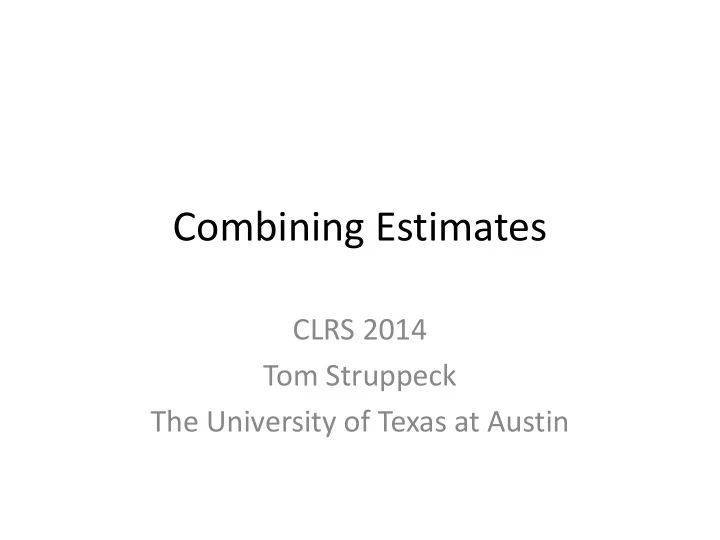

Combining Estimates CLRS 2014 Tom Struppeck The University of Texas at Austin
Goal: Make a new estimator from old ones Two cases: – Case 1: Multiple estimates of one quantity – Case 2: Desired quantity is a function of several quantities each with individual estimates
Accuracy vs Precision
Optimization • Could optimize accuracy • Could optimize precision • Could try to optimize both simultaneously – Root mean square error
Two unbiased estimators for the same quantity The red and blue curves are the densities for two estimators for an unknown parameter. The black curve is the density of the optimal combination of these two estimators. 2 Normal (250,30 ) 2 Normal (275,40 ) 2 Normal (259,24 )
The optimal combination Think of red as the original estimate and blue as new information. black = Z* blue + (1 - Z)* red 2 30 Z = Where: + 2 2 30 40
The new estimate is more precise • Is it more accurate? Here are the centers of the three distributions: <……..…….. 250 ….. 259 ………. 275 ……..….> No matter where on the number line the true value is, 259 is closer to it than at least one of 250 and 275
Sums and Averages Often, we are interested in a total. Typically we will have estimates for the summands. n n ∑ ∑ = E ( X ) E X ( ) i i = = i 1 i 1 This holds whether the summand are independent or not. Divide by n to see it holds for averages, too.
The Central Limit Theorem states that an average of independent random variables will converge (in distribution) to a normal random variable under very general conditions. (Assume IID for the rest of this slide.) The variance of the n th average will be 1 proportional to . n The variance of the n th sum will be proportional to n. NOTE: This goes to infinity with n.
What does that mean for us? If we add together independent random variables, the variance of the sum is larger than the variance of the individual summands. This is also true for correlated random variables unless the correlations are close to -1. Our estimate of the sum will generally be less precise than our worst summand.
But all is not lost Despite the fact that the variance is getting bigger, it is often the case that the expected value is also increasing, suppose that these are both increasing proportionally with n. But, the standard deviation, being the square root of the variance, is growing more slowly, so the coefficient of variation (the ratio of the mean to the standard deviation) is going to 0.
An Example
An example with correlation 25 th -percentile losses 75 th -percentile losses Line of Business Expected losses St. Dev. (Est.) Estimated CV A 100 90 110 14.8 0.148 B 225 150 300 111.2 0.494 C 350 200 500 222.4 0.635 Naïve Total 675 440 910 348.4 0.516 With Covariance 675 465.3 884.7 310.9 0.461 Adjustment
Recommend
More recommend